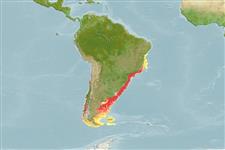Common names from other countries
Environment: milieu / climate zone / depth range / distribution range
Écologie
; profondeur 10 - 100 m (Ref. 83435). Subtropical, preferred 22°C (Ref. 107945); 12°S - 56°S, 76°W - 37°W (Ref. 112047)
Distribution
Pays | Zones FAO | Écosystèmes | Occurrences | Introductions
Southeast Pacific and Southwest Atlantic: From Bahia, Brazil and Mar de Plata, Argentina to Chile (Magellan region). Subtropical to temperate.
Length at first maturity / Taille / Poids / Âge
Maturity: Lm ? range ? - ? cm Max length : 5.6 cm DL mâle / non sexé; (Ref. 83435)
Life cycle and mating behavior
Maturité | Reproduction | Frai | Œufs | Fécondité | Larves
Members of the class Bivalvia are mostly gonochoric, some are protandric hermaphrodites. Life cycle: Embryos develop into free-swimming trocophore larvae, succeeded by the bivalve veliger, resembling a miniature clam.
Rosenberg, G. 2005. (Ref. 3446)
Statut dans la liste rouge de l'IUCN (Ref. 130435: Version 2024-1)
statut CITES (Ref. 108899)
Not Evaluated
Not Evaluated
Utilisations par l'homme
Pêcheries: commercial
FAO - pêcheries: landings | FishSource | Sea Around Us
Outils
Plus d'informations
Taille/Âge
Croissance
Longueur-poids
Longueur-longueur
Morphologie
Larves
Abondance
Sources Internet
Estimates based on models
Vulnérabilité
Low vulnerability (10 of 100).
Catégorie de prix
Unknown.
